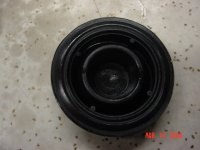Re: more blaspheme
[ QUOTE ]
gents,im not gettin this,ya buy a seal for resv.cap but its got a "slit" in it,is that the deal? then you buy rtv to seal the "slit".if thats whats bein done its a heck of a trick,why dat "slit" be dar in da first place? perhaps its "not ment to totaly lock the system up? why do there be a hole in the top of the cap? any one blow a brake cyl. yet? got leaks? maybe braking that dont release to quick when ya take your foot off the pedal,brakes that "bite" to fast?well then thats a nifty accumulator ya just built,why they tell ya to keep your hole clean,the one on top of cap that is? trying to keep moisture out of a system that wont be effected by it for about 100 years seems futile to me, the prospect of doin this trick has me more "confuseded" then i normally am,and thats really bad! /ubbthreads/images/graemlins/confused.gif
[/ QUOTE ]
More modern master cylinders have a bellows type seal on the lid. Since the rubber is folded & very flexible it does not act as a pressure accumulator but only displaces slightly to provide for the slightly varying fluid volume. The hole in the metal lid allows for volume changes on the fluid side without exerting pressure on the fluid. A slit in the rubber is not needed to equalize pressures. The seal prevents exchange of moisture laden air through the cap hole & keeps the fluid drier.
Why the seal in question has a slit is unknown. Sealing the slit has proven to not have any adverse effects & does provide a fully sealed system. I don't think that rtv is compatible with brake fluid. I do know that JB weld works well.
Some master cylinders have residual pressure valves which maintain around 2 psi on disc brakes, to 10 psi on drum brakes, of positive pressure on the braking system even when the pedal is fully released. This residual pressure prevents unwanted entry of air into the wheel cylinders when the brakes are not applied. It keeps the cups slightly expanded. The retraction forces on the brake shoes & calipers are great enough to overcome this residual pressure so that the brakes don't drag. This residual pressure is higher than any pressures that would be exerted by the master cylinder rubber cap seal.
D

 Hi Guest!
Hi Guest!

 smilie in place of the real @
smilie in place of the real @
 Pretty Please - add it to our Events forum(s) and add to the calendar! >>
Pretty Please - add it to our Events forum(s) and add to the calendar! >> 

